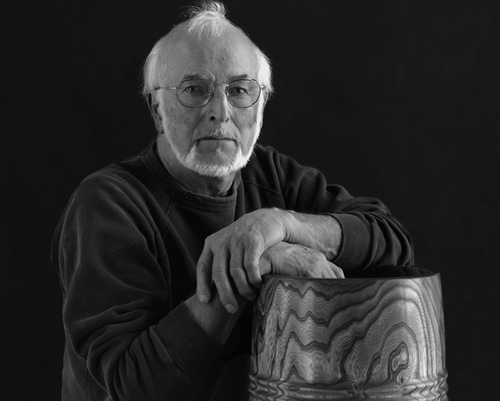
Portrait de Gordon Dunphy, Strathbutler 2002(photo – James Wilson)
… disait toujours que « le bois lui parlait » et que, par conséquent, son art parlait à beaucoup …
Gordon Dunphy est né dans une vieille famille agricole du Nouveau-Brunswick dans la vallée arrosée de Nachonac. Il a passé la plus grande partie de sa vie comme un exploitant de ferme laitière hautement respecté, se spécialisant dans l’élevage. M. Dunphy n’a jamais reçu de formation officielle, mais s’établissait lui-même dans un studio à Taymouth (Nouveau-Brunswick). Il eût tôt fait d’être reconnu pour ses créations éloquentes de pièces en bois tourné, faisant valoir les caractéristiques distinctes du matériel original. Personne ne s’attendait à autre chose de sa part jusqu’au jour où, en 1981, il abandonna la ferme pour s’adonner à son propre art, à son imagination et à sa poésie dans sa poursuite de l’ouvrage en bois tourné. Les invitations à exposer son oeuvre au Canada et en Europe n’ont pas tardées à venir; ainsi il connut une renommée à l’échelle internationale en sa qualité de maître d’œuvre.
Le respect que vouait Gordon Dunphy à son matériel lui a permis de transcender son propre métier. Il ne voyait ni le bois comme moyen de passer son message ni comme un véhicule pour ses techniques virtuoses en bois tourné. Plutôt, le bois était jadis une substance vivante, un sujet digne de sa collaboration. Quand il décrivait son œuvre, Gordon disait toujours que « le bois lui parlait » et que, par conséquent, son art parlait à beaucoup.
- Une galerie de l’œuvre de Gordon Dunphy
- Tous les postes sur Gordon Dunphy
La contribution de Gordon Dunphy au paysage culturel du Nouveau- Brunswick a été marquée par une panoplie de prix. En 1980 et en 1988, il recevait le New Brunswick Crafts Council Premier’s Prize (Prix du Conseil des artisans du Nouveau-Brunswick); en 1995, le prix Kjeld et Erica Dykeman pour excellence en artisanat, et, en 2002, il obtenait le prestigieux prix Strathbutler pour excellence en métier d’art et en arts visuels. Après avoir souffert du cancer, M. Dunphy s’éteignait à l’âge de 74 ans.
